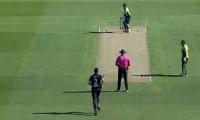Answer: Dera Bugti, Charsadda, Khyber Agency, Sehwan Sharif, Mohmand Agency, Peshawar and Lahore. Question: Are we winning the war against militancy? Ever since Operation Zarb-e-Azb was launched, we were told the militants would be defeated, were about to defeated or had already been defeated. What Zarb-e-Azb couldn’t do, the National Action Plan would manage. After two years and 274 convictions secretly handed down, we are still being told military courts might be the answer. Fear not, Operation Radd-ul-Fasaad is here.
Being irascible about yet another military operation is easy but useful. The supposed success of Zarb-e-Azb inflated many reputations while critical voices were dismissed as the usual whining of the perpetually aggrieved or, worse, borderline treasonous. Now that we all know militancy was anything but routed by the operation it might be instructive to look at what many had complained about when Zarb-e-Azb was launched.
Relying on only a military operation and that too only in the tribal areas was never going to be enough. Militancy did not begin in Fata and it was not going to end there. There was an element of convenience in choosing only the place that is both physically and constitutionally remote from the country’s power centre. Fata has always been treated with condescension, its people seen as brave warriors but little else. Now it is becoming impossible to ignore that militancy is as much a problem for Punjab as it is for Fata. The meeting which decided on launching Operation Raddul Fasaad had the Punjab Rangers present and it seems to have committed to rooting out militants in the most populous province.
The ideological forbearers of the TTP and its ilk can be found in Punjab. Sipah-e-Sahaba Pakistan, Lashkar-e-Jhangvi, Jaish-e-Muhammad have been around in the province since the 1980s and continue to thrive under various name changes prompted by ineffectual bans. But they have always been treated differently to the TTP, never quite seen as enemies of the state. As long as they were busy hijacking the liberation movement in Kashmir – thus robbing it of legitimacy in the eyes of the world – the state was happy to leave them alone even if their main target here was the Shia community.
The rise of the TTP changed the equation. The madressah networks set up by these groups ended up not just populating their own ranks but, often to their chagrin, that off the TTP too. This is the problem with radicalisation. The monster cannot be directed by remote control. Punjabi militant groups realised there was a new power centre and it began to work with them. The Punjabi Taliban developed as a separate entity and was responsible for some of the most devastating attacks in the country
As far back as 2010, Shahbaz Sharif was begging the Taliban to leave Punjab alone, saying the Taliban and the PML-N both opposed Pervez Musharraf and so there was no reason to carry out attacks in the province. The PML-N’s relationship with extremist groups in Punjab went a little deeper than common opposition to a dictator. It vied for support from the same constituencies from which the groups populated their ranks. Taking action against someone who has appeal among your vote bank was not considered smart politics. So the power of the militant groups grew.
Well-meaning criticism of Zarb-e-Azb pointed out that military might alone was never going to cut it. Violent militant groups are the physical manifestation of a mindset that has been carefully nurtured and nourished. Decades of propaganda was not going to be erased by relentless bombing. The National Action Plan claimed to work in a more comprehensive direction. It promised not to make distinctions between ‘good’ and ‘bad’ militant groups; it vowed not to allow extremist elements to appear in the media; it was going to ensure old groups would not reappear under new names.
The successes of the National Action Plan were insubstantial. Official representatives of militant groups were kept off the air but their unofficial representatives still occupied the host’s chair. The Lashkar-e-Taiba had previously begat the Jamaat-ud-Dawa. Now the Jamaat-ud-Dawa begat the Falah-e-Insaniat Foundation. The ‘good’ militants were left alone, so long as the fruits of their militancy were borne here.
Wherever there were roadblocks, a convenient shortcut was found. Convicting alleged militants in court was too much hard work so military courts were set up. Military justice, as First World War-era French leader Clemenceau said, is to justice as military music is to music. He was also the one who said war is too serious a matter to leave to soldiers but we have never heeded that advice either.
The legal war against militants was hamstrung by shoddy investigations and scared prosecutors, witnesses and judges. A lot of the problems with the investigative process were pointed out by Justice Qazi Faez Isa in his Quetta attack commission report but it was more fun for everyone to focus on the juicier bits about the interior minister. We never bothered reforming the judicial process, setting up a functioning witness protection programme and trusting the judiciary. We just set up courts that had lower evidentiary standards along with the power to end a person’s life without appeal. Now we want to bring those courts back just weeks after they lapsed, even though there is no proof that military courts had any deterrent effect. How could they when the militants they are meant to deter are already committed to die in the name of their cause?
The National Action Plan did not address the vital Afghanistan question and now we are paying for that too. For decades – dating back to the mujahideen – our chief export to Afghanistan has been militancy. The Afghan Taliban and the Haqqani Network, whether by neglect or more likely design, were low on our list of priorities. Yet we managed to summon up outrage over the leadership of the TTP finding safe refuge in Afghanistan. As ye sow, so shall ye reap.
What is most worrying is that we do not seem to be doing anything different this time around. The addition of Punjab to the repackaged military operations will not change much. Sure, as with Zarb-e-Azb, it might force Punjab-based militant groups on the run and buy us some breathing space for a couple of years. But, if the demand and supply theory is to be believed, they will regroup and draw new recruits so long as we allow the ideology to spread.
Even if militants number in the tens of thousands, they alone would be no match for the power of the state. It is the millions more who may never pick up arms but who are sympathetic to the aims of these groups that nourish them. The state has been an accomplice in producing these millions and it has found it difficult to abandon the policies and practices that created the monster that is now devouring us one attack at a time.
The writer is a journalist
based in Karachi.
Email: nadir.hassan@gmail.com
Internationally, there have been misleading theories propounded about so-called slowing of Chinese economy
Karachi has long been Pakistan’s financial capital and a major hub for industry and trade
In the past, with every rising of the sun, much anticipation was associated with reading the newspaper
It is clear that more is at stake as US abandons its role as global leader of system based on multilateralism
I believe that those who adopt attitude of forgiveness, mercy and tolerance are role models for all of humanity
First major point of contention between Brussels and Washington is the unequal distribution of defence expenditure







